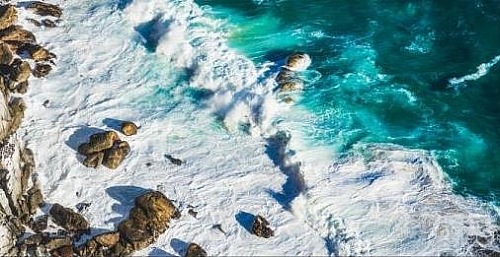Table of Contents
What is Salinity?
Salinity is simply defined as the degree of saltiness or concentration of salt in oceans. Or it is the amount of dissolved solids in seawater. Sea water contains mineral salts, the main ones being sodium chloride which is same as table salt, calcium bicarbonate which provide marine organisms with calcium carbonate essential for the formation of shells, bones and other hard parts in marine animals and plants, magnesium chloride and magnesium sulphate.
Dissolved minerals in sea water are gotten from weathering of minerals and rocks on dry land. The dissolved minerals are transported to the sea by rivers or by underwater eruptions of sea-floor volcanoes and volcanic vents. The degree of saltiness varies from ocean to ocean and it is often measured in parts per thousand grams. The average salinity of the ocean is 35 grams for every 1000 grams of water. In maps, all oceans having the same degree or amount of saltiness are often joined together with a line call ISOHALINE.
Some areas of the ocean are saltier than others, hence the saltier the water the denser it is. salty water cannot freeze, so when sea ice forms, the water freezes, leaving the salt in the ocean which becomes more saline as a result. The increased salinity increases the density of the sea water and also enables it to cool further. This process is known as brine rejection.
Why is the ocean salty?
Ocean salinity is more complex than it may seems, the ocean was not always salty as it is today. It is believed that the original oceans on Earth were made up of freshwater bodies that have rapidly changed and became salty waters as chemical weathering of minerals and rocks on dry land contributed to salts in the sea over time.
Salinity together with temperature play important roles in the explanation of ocean circulation, water cycle and climate change, which makes both very important variables to consider. When high salinity and low temperature combines together, they make seawater very dense and then begin to sink to the bottom of the ocean and flows acrossocean basinsas deep and slow currents.
Salinity varies from ocean to ocean and from place to place. In water bodies that are not open such as the lagoons, bays, lagoons and estuaries have lower salinity compared to open seas like the Atlantic oceans. There are parts of the ocean that hardly receive rain water, only warm dry winds occur here and thus cause lots ofevaporation of water. When evaporation occurs and water vapor rises into the atmosphere, it removes water from the ocean leaving behind salt, this process causes the sea water to become denser and hence increases its salinity as well. Similarly, there are some parts of the ocean that receives more rainfall than others. When this happens, a large amount of freshwater is added at the surface which dilutes the seawater, this fresh water reduces the salinity and thus makes the seawater less dense.
However, seawater with lower salinity is lighter in density and wont sink as much as denser water, this process changes ocean currents. Also, since the vaporization of sea water and formation of ice are causes of increase of ocean salinity, then an increase or decrease in ocean salinity could mean whether or not sea water is vaporizing and icebergs are forming.
Average salinity of the ocean water
The average salinity of the ocean is 35ppt for every 1000 grams of water, This entails that in every kilogram (1000 grams) of seawater, 35 grams contain salt. North Atlantic ocean contains the warmest and saltiest water of the major oceans, the Southern Ocean (the region around Antarctica) is the coldest, and the North Pacific has the lowest average salinity.
Factors affecting the salinity of the ocean water
- The amount of fresh water: fresh water is gotten from rain, rivers, streams and melting ice. The more the volume of water is added to the ocean, the lower the degree of saltiness as these are experienced within the equatorial lands. On the other hand, the lower the amount of fresh water that comes into the ocean, the higher the degree of saltiness.
- The degree of water mixing with ocean currents: within the enclosed water bodies such as the Caspian and Red Sea, the salinity is very high because of the absence of ocean current mixing with it, whereas in seas that are not enclosed the degree of their mixing with ocean current is very high hence there is reduction in salinity.
- The rate evaporation: in the tropics, the higher the rate of evaporation in the ocean water the higher the salinity, whereas in the arctic region the lower the evaporation of the ocean water, the lower the salinity.
Why is the salinity of the ocean important?
- Salinity is used for determining the density of seawater
- It affects the freezing point of seawater
- It affects the temperature of maximum density of seawater
- Salinity changes in salinity drive thermohaline circulation
- Salinity records the physical processes affecting a water mass when it was last at the surface. a. precipitation/evaporation-salts excluded from vapor b. freezing/thawing salts excluded from ice
- Salinity can be used as a conservative (unchanging) tracer for determining the origin and mixing of water types.
